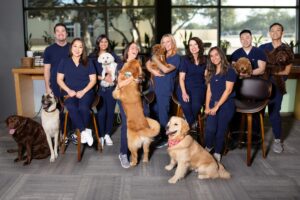sponsored content
May 1, 2023
By Laurie Sorrenson, OD, FAAO, and Eric Hammond, OD
One of the most significant pieces of advice when hiring any myopia management employee is to be sure to take as much time as necessary to find the right person. They can be an enormous asset to your practice, and it’s worth it to take the time to find someone who’s passionate about myopia management and who will do the job right.
We opened our practice, Lakeline Vision Source, in Cedar Park, Texas, in 1995. Then, almost 20 years to the day in 2015, we built an 11,000-square-foot office in which we now practice.
Our office has been offering patients myopia management in a very non-aggressive, informal way for about 15 years. It wasn’t until about five years ago — when we joined Treehouse Eyes — that we formalized our myopia management program, which ultimately helped us take it to the next level. When we first made the shift to get serious about myopia management, we had about 30 employees. Since then, we’ve grown to have 44 employees and nine full-time doctors. Every year since moving into the new building, our practice has grown by double digits percentage-wise. In the last two years, we grew 40%. Overall, we’ve seen steady growth year over year, with pretty significant spikes when we first opened our new office and over the last two years.
Getting Specific About Myopia Management Roles
In our practice, one role crucial to our myopia management program is the Myopia Management Counselor. She works to make the follow-up appointments with myopia management patients, meets with prospective children/parents, and explains the entire program. Our goal is to use as little doctor time as possible because we found that we would charge a global fee for myopia management services, but then the doctor would see the patient six times a year, and chair costs would go up and up and up.
Now, we have one dedicated person who can do most of the follow-ups, and the doctor only does the six-month refraction exam. This transition to having this specific role has been super important for us, as it allows our doctors not to be bogged down with the minutiae and focus their attention on patient care.
Filling the role of Myopia Management Counselor is of the utmost importance as they are the practice’s myopia management representative to our patients. You can either promote this person from within or hire them from a variety of available candidates. Prior to becoming the Myopia Management Counselor, the employee in our office was previously a technician. She had already been working with Paragon CRT orthokeratology lenses and other myopia management contact lenses and had been in the field for a long time. For this role, she attended various myopia meetings and continuing education courses, and she completed training through Treehouse Eyes. We meet with her routinely to go through the processes on the business side of myopia management and ensure that our clinical protocols are up to date.
 |
 |
At Dr. Sorrenson and Dr. Hammond’s practice, the Myopia Management Counselor plays a critical role.
Being Comfortable Talking About Money
When looking for someone to fill the Myopia Management Counselor role, one of the most important criteria is that the candidate must be comfortable talking about money. Myopia management can be considered expensive by some, and this person needs to be confident talking about fees. They need to communicate with parents why these treatments are worth it. However, at the same time, this person also needs to be clinically astute.
Additionally, the Myopia Management Counselor has a lot of clinical responsibilities. In our office, she conducts visual acuity, autorefraction, biometry, and topography. She also explains the ins and outs of myopia management, so whoever fills that role needs to be comfortable with the medical aspect. This person also needs to be independent and comfortable doing follow-up care alone.
On top of that, there needs to be a level of intrinsic motivation. The person filling this role needs to think that myopia management is exciting and cool and wants to dive deep into it every day. Going hand in hand with that, this candidate needs to see the value of myopia management.
Filling this role may be one of the hardest in the whole office. It takes a unique personality and doesn’t fit the normal optometric technician personality. It actually fits more of the optical personality, but when you hire someone for the optical, they typically aren’t medically interested, so that piece is missing.
Staff Training Is Critical on Diagnostic Equipment
For our Myopia Management Counselor, one of the critical areas of training is on the diagnostic equipment. The two primary devices they’ll need to be able to use are the biometer and the topographer. All of our techs learn how to use these devices, and they can use them on any patient. They do it during the workup, so if the patient is a nearsighted child, they run the axial length measurement and do the topography. They also need to be proficient with the slit lamp and contact lens insertion and removal training.
When it comes to training our staff, we place a significant emphasis on continuing education. We have weekly meetings with our staff members, and we pick a different area to focus on each quarter. Then, we structure our weekly meetings to reflect the specific quarterly topic. This quarter, our focus was on myopia management. We got the staff involved to take a quiz about how we treat myopia, which treatment we utilize the most in our office, and other similar questions. It was an excellent discussion with the staff, and it helped reinforce what we’re doing and why we’re doing it.

Since moving into a new office in 2015, Dr. Sorrenson and Dr. Hammond’s practice has grown double digits percentage-wise.
Getting together with our staff for meetings is an integral part of our time in our practice. Every Wednesday, we have office meetings, Thursdays we have doctor meetings, and Mondays we have admin meetings. Once a quarter, we try to do an offsite meeting with our main team. In meeting so frequently, we can consistently reinforce our core values with our staff. We all get to be together as a group, feed off each other, learn from each other, and always go back to our core values — one of which is having fun.
Take All the Time You Need to Find the Right Person
One of the most significant pieces of advice when hiring any myopia management employee is to be sure to take as much time as necessary to find the right person. They can be an enormous asset to your practice, and it’s worth it to take the time to find someone who’s passionate about myopia management and who will do the job right.
Being focused on one thing at a time is also helpful to consider. When we first started with myopia management, we were trying to implement Neurolens and a new dry eye device at the same time. We were doing three big things at once, and we couldn’t get a good foothold on implementing anything. Especially for practitioners with larger practices, it can be challenging to focus on one specialty at a time.
Ultimately, as doctors, we also need to get comfortable delegating some of our responsibilities to our employees. The key to getting profitable with myopia management was creating a role specifically for these patients and allowing that employee to take on most of the workload. That’s when you’ll see this become a valuable service in your practice.
 |
Laurie Sorrenson, OD, FAAO, opened Lakeline Vision Source in 1995. She is Board Certified (less than a dozen optometrists in the Austin area hold this distinction) and is a part-time faculty member at the University of Houston College of Optometry where she teaches practice management to optometry students in their fourth year. Dr. Sorrenson received her Doctor of Optometry degree from the University of Houston, College of Optometry in 1985. She earned her Academy Fellowship from the Academy of Optometry in 1999 and became licensed as an Optometric Glaucoma Specialist. Dr. Sorrenson also lectures around the country and in Canada on different topics, including staff management, practice efficiencies, keratoconus, and contact lenses, and she consults with other optometrists to help them to better manage their practices. She is the Professional Editor of Review of Optometric Business.
|
 |
Eric Hammond, OD, is a second generation optometrist practicing with his mother, Dr. Laurie Sorrenson. He completed his Doctorate at the University of Houston College of Optometry, where he spent a spring internship rotating through different clinics in Oklahoma, diagnosing, treating, and managing a wide variety of diseases, as well as performing eye laser procedures. He also spent a semester in Dallas, working at a non-profit eye care clinic that specialized in the treatment of glaucoma and diabetic retinopathy for lower income patients. Dr. Hammond is presently licensed as a Therapeutic Optometrist and as an Optometric Glaucoma Specialist. He is a member of the Texas Optometric Association and the American Optometric Association. |
For more insights on staffing, hiring, or finding a job in myopia management, check out this article that’s also from Eyes On Eyecare, which sponsored this article.














